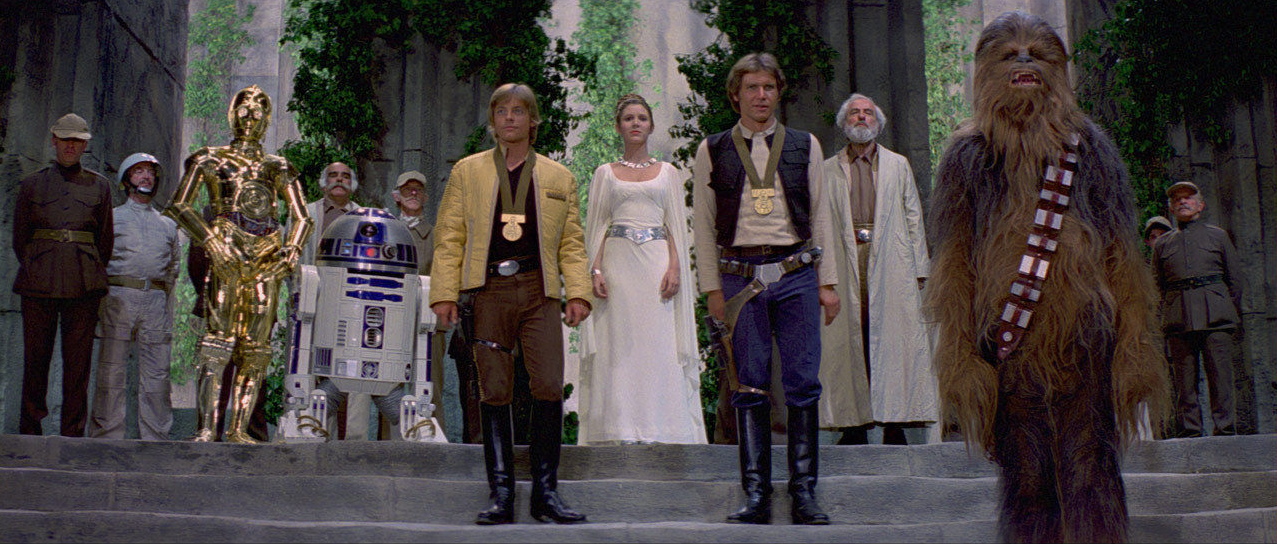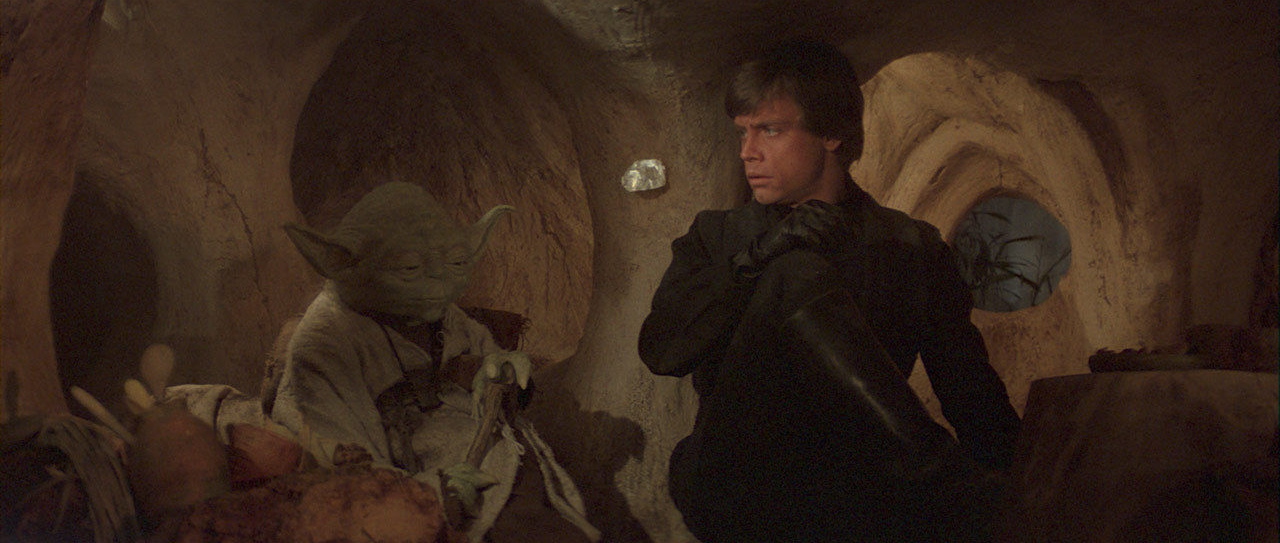Why We Still Love 'Star Wars' After All These Years

Nearly 40 years after the first "Star Wars" film debuted, the iconic sci-fi movies remain as popular as ever, capturing the imaginations of multiple generations and gaining new fans as the next movie in the franchise, "The Force Awakens," premieres this week.
"Star Wars" is a cultural phenomenon like few others. The films that George Lucas produced (he directed four) were consistently the highest grossing of their respective eras. According to Box Office Mojo, from its release in May 1977 to the end of the year, "Star Wars" pulled in some $194.8 million in the United States alone. (That's $750 million adjusted for inflation) "The Phantom Menace," released in May 1999, earned $431 million by year-end and set records for how fast it hit the $200 million mark. ['Star Wars' Tech: 8 Sci-Fi Inventions and Their Real-Life Counterparts]
Meanwhile, Darth Vader's name has become synonymous with bad guys. Princess Leia's line, "Help me, Obi-Wan Kenobi; you're my only hope," has been endlessly imitated and parodied.
"Star Wars" wasn't the first Hollywood science fiction film, but it cleared the way for countless imitators, and even new film franchises, in a way no other movie did. And for science fiction fans, it still endures the test of time. Why?
One huge factor is that "Star Wars" wasn't just a good movie; it also employs very old story ideas, said science fiction writer James E. Gunn, a founding member of the Center for the Study of Science Fiction at the University of Kansas.
"We all rely on the tropes that we inherit from our genre predecessors — the concepts, the ideas and hope to shape them into something new and different, even to make art out of them," Gunn said. "'Star Wars' used them very well, and it was a source of strength."
Much of the film's core plot and pacing is drawn from old "Flash Gordon" serials, which Lucas himself cited as inspiration. But that wasn't the only source. Gunn told Space.com about an incident involving Brian Aldiss, another respected science fiction writer. In 1978, "Battlestar Galactica" appeared on television, and 20th Century Fox, which had bankrolled "Star Wars," sued Universal Studios, the producers of "Battlestar Galactica." According to Gunn, Aldiss, working for the defense in the lawsuit, found an Astounding magazine cover with an alien that seemed identical to a Wookiee and a Galaxy cover that looked like the band in the "Star Wars" cantina scene. Gunn said the skeleton of a sand worm in the desert is an homage to the Frank Herbert book "Dune."
Breaking space news, the latest updates on rocket launches, skywatching events and more!
Keith Phipps, a film critic who has written often about "Star Wars" — both the prequels and the original films — noted that it might also have been the kind of movie Americans wanted at the time. He noted that another multifilm franchise, "Planet of the Apes," was dystopian. And although "2001: A Space Odyssey" was a big-budget success as a film, it was probably too cerebral. 1976's "Logan's Run" was also a pretty bleak vision.
Part of the reason "Star Wars" caught on might have been that "it felt like the right movie at the time," Phipps said, adding, "Sci-fi got grimmer and more dystopian." Americans wanted and needed something different. [Science Fact or Fiction? The Plausibility of 10 Sci-Fi Concepts]
One other factor that makes "Star Wars" so alluring is the world building. Teresa Jusino, assistant editor at the pop culture site The Mary Sue, said the movies presented a world that could be expanded — and it has been, via spin-off series, novels and comic books.
"I am a sucker for world building," she said. "In science fiction, it's not the hard-science stuff that draws me in; it's tooling around the galaxy, seeing new stuff." The "Star Wars" movies put a lot of effort into creating believable aliens, for instance — famously in the cantina scene, but in every other film as well. "It's such a rich world; there's always going to be able to be new stories and new incarnations," Jusino said.
Jusino added that she didn't even see the first film until she was an adult. But through the '80s and '90s, the cultural references had wormed their way into many other areas — lines on an episode of "Friends," for example. "I knew a lot of the story already from what people had told me," Jusino said.
In fact, by the time "The Phantom Menace" was released in 1999, many people who had seen the first "Star Wars" movie as kids were starting to get jobs in the TV and movie industries, said Robert McNees, a physicist at Loyola University in Chicago and a fan who first saw the film as a child. "When you talk about 'Star Wars,' you're really talking to someone's childhood," he said.
That appeal to children is important, McNees said. Other science fiction films at the time did not have that kind of charm, and the fact that lots of children saw it made a huge impression, especially for kids who were already interested in space, as he was. "For me, it was like imagination gasoline," McNees said.
Another factor in the enduring popularity of "Star Wars" was the behind-the-scenes crew. John Williams, who wrote the film's famous musical score, had won an Oscar for his work on "Jaws" (and has since won four more). Less well known are Ralph McQuarrie, who did the concept art, and sound designer Ben Burtt, who went on to edit the prequel trilogy.
"There was just this amazing combination of talent there," Phipps said. "It's like the four guys getting together in Liverpool to create The Beatles."
Indeed, many out-of-this-world factors came together to give "Star Wars" its enduring appeal. Will it stand the test of another 40 years? It's our only hope it will.
You can Follow Jesse Empsak @Mad_Science_Guy. Follow Space.com on Twitter @Spacedotcom. We're also on Facebook & Google+. Original article on Space.com.

Jesse Emspak is a freelance journalist who has contributed to several publications, including Space.com, Scientific American, New Scientist, Smithsonian.com and Undark. He focuses on physics and cool technologies but has been known to write about the odder stories of human health and science as it relates to culture. Jesse has a Master of Arts from the University of California, Berkeley School of Journalism, and a Bachelor of Arts from the University of Rochester. Jesse spent years covering finance and cut his teeth at local newspapers, working local politics and police beats. Jesse likes to stay active and holds a fourth degree black belt in Karate, which just means he now knows how much he has to learn and the importance of good teaching.



